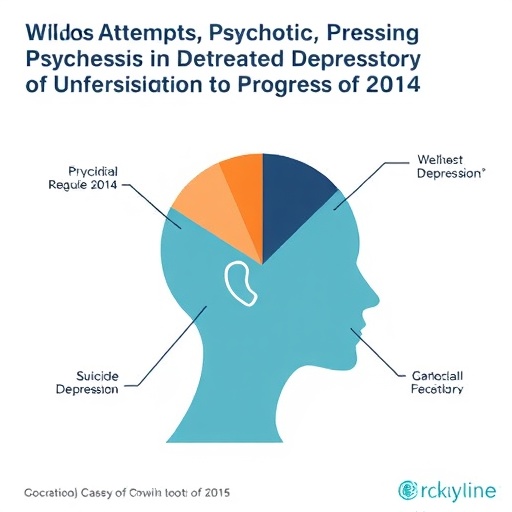In a groundbreaking study published in BMC Psychiatry, researchers have illuminated the complex interplay between suicide attempts and psychotic symptoms within the context of major depressive disorder (MDD). This exploration centers on a uniquely vulnerable population: first-episode, drug-naïve (FEDN) patients. By focusing on individuals who have yet to receive pharmacological treatment, the study offers unparalleled insights into the natural course and clinical characteristics of MDD, untainted by medication effects. The findings bear profound implications for early intervention strategies and the prognostic evaluation of depressive disorders.
Major depressive disorder, a condition affecting millions worldwide, manifests with a diverse spectrum of symptoms. Among the most alarming are psychotic symptoms—such as hallucinations and delusions—and suicide attempts, both of which signify severe disease progression and heightened clinical risk. Previous research has established that the coexistence of these conditions correlates with poorer outcomes, but until now, quantitative data regarding their prevalence and associated factors in untreated, first-episode patients have been scarce.
The research engaged 1,718 FEDN MDD patients, making it one of the largest cohort studies examining this specific intersection. Comprehensive data encompassing sociodemographic profiles, clinical symptom evaluations, and biochemical markers were systematically gathered. This meticulous approach allowed for the parsing out of distinct clinical subgroups, particularly focusing on those exhibiting comorbid suicide attempts and psychotic symptoms (SAPS).
Surprisingly, the prevalence of SAPS within the cohort was relatively modest, accounting for approximately 4.4% of the sampled patients. While seemingly a small fraction, this subgroup’s clinical profile revealed significantly heightened severity across multiple dimensions. Those with SAPS were notably older on average but paradoxically exhibited an earlier age of disease onset, suggesting a complex trajectory that warrants deeper investigation into developmental and neurobiological underpinnings.
Clinically, the comorbid group scored markedly higher on standard assessment scales for depression and anxiety, specifically the Hamilton Depression Rating Scale (HAMD) and the Hamilton Anxiety Scale (HAMA). Additionally, the Clinical Global Impressions-Severity of Illness scale (CGI-SI) underscored the intensified severity of illness in these patients. These elevated scores underscore the intertwined nature of affective and psychotic symptomatology in exacerbating risk and diminishing quality of life.
Of particular interest were the distinct variations observed in thyroid hormone levels among patients exhibiting SAPS. Thyroid function, often overlooked in psychiatric evaluations, emerged as a significant biochemical correlate. Increased thyroid-stimulating hormone (TSH) levels were found to be strongly associated with the presence of SAPS, emphasizing a potential neuroendocrine pathway that may mediate or amplify psychiatric symptom severity. This finding invites further exploration into the role of peripheral endocrine factors in central nervous system pathophysiology.
Advanced statistical modeling reinforced these associations. Odds ratios indicated a robust link between elevated anxiety scores (HAMA), illness severity (CGI-SI), TSH levels, and the likelihood of SAPS manifestation. Specifically, higher anxiety levels nearly doubled the odds of SAPS, while elevated CGI-SI scores increased it eightfold, highlighting illness severity as a pivotal determinant. Elevated TSH levels also doubled the odds, positioning thyroid dysfunction as a non-negligible biological risk factor.
The predictive power of these variables was validated through receiver operating characteristic (ROC) curve analyses. Each marker individually demonstrated considerable discriminative capability, with area under the curve (AUC) values exceeding 0.86. Remarkably, when combined, the model’s AUC soared to an impressive 0.980, denoting near-perfect accuracy in identifying patients at heightened risk for SAPS. This potent combination of clinical and biochemical indices could revolutionize early screening and targeted intervention frameworks.
These data collectively underscore the necessity of integrating psychiatric symptomatology assessments with endocrinological evaluations in newly diagnosed MDD patients. The identification of anxiety levels, overall illness severity, and thyroid function as intertwined risk factors offers a multidimensional lens for understanding the nuanced progression of depressive disorders complicated by psychosis and suicidality.
Moreover, the focus on first-episode, drug-naïve patients sheds light on the natural history of MDD without pharmacological confounds. This is crucial for delineating primary pathophysiological mechanisms from treatment-emergent phenomena. It also lays the groundwork for personalized medicine approaches, encouraging clinicians to consider a broader set of diagnostic parameters beyond traditional mood assessments.
The implications of these findings are profound for public health and clinical practice. Early identification of patients at risk for suicidal behavior and psychotic features could dramatically decrease morbidity and mortality rates in MDD populations. Incorporating routine thyroid function testing and anxiety severity scales into initial assessments may enable more nuanced tailoring of therapeutic strategies, potentially improving long-term outcomes.
Additionally, this study paves the way for future research aimed at unraveling the mechanistic pathways linking thyroid dysfunction to psychiatric symptoms. Understanding whether thyroid abnormalities actively contribute to neuropsychiatric vulnerability or merely serve as biomarkers could have transformative effects on treatment paradigms, possibly incorporating endocrinological interventions.
An intriguing avenue arises in dissecting the temporal dynamics between anxiety and psychotic symptoms within depression. Given anxiety’s prominent role as a predictor, examining its modulation over time and its interaction with psychosis onset could refine risk stratification methods, ultimately informing preventative measures.
In conclusion, this extensive exploration into the prevalence and correlates of comorbid suicide attempts and psychotic symptoms in untreated, first-episode MDD patients offers crucial clinical and scientific insights. By elucidating the roles of anxiety severity, illness severity, and thyroid function, it provides a composite framework for risk assessment that could significantly improve early detection and intervention efforts.
As mental health practitioners grapple with the complexities of depression, these findings advocate for a more holistic evaluation strategy that transcends symptom checklists, blending phenomenological assessment with biological markers. The ultimate hope is that such multidimensional approaches will translate into better patient outcomes, reducing the devastating human toll of depressive disorders complicated by suicidality and psychosis.
Subject of Research: Comorbid suicide attempts and psychotic symptoms in first-episode drug-naïve patients with major depressive disorder.
Article Title: Prevalence and related factors of comorbid suicide attempts and psychotic symptoms in first-episode drug-naïve patients with major depressive disorder.
Article References:
Liu, A., Yin, H., Feng, X. et al. Prevalence and related factors of comorbid suicide attempts and psychotic symptoms in first-episode drug-naïve patients with major depressive disorder. BMC Psychiatry 25, 733 (2025). https://doi.org/10.1186/s12888-025-07186-4
Image Credits: AI Generated




